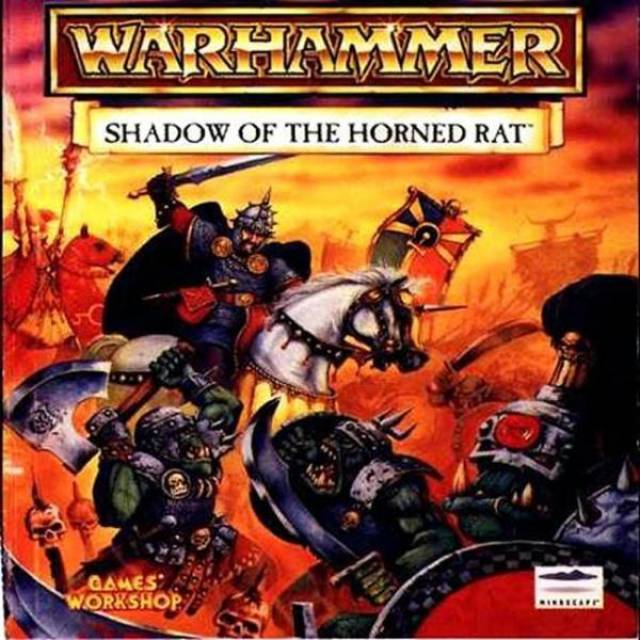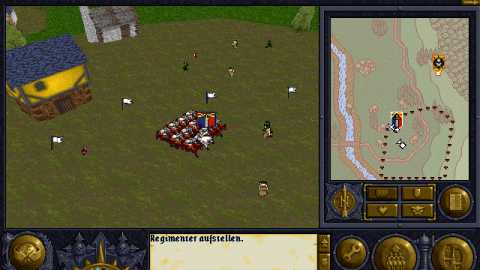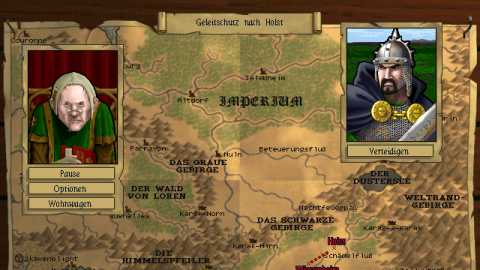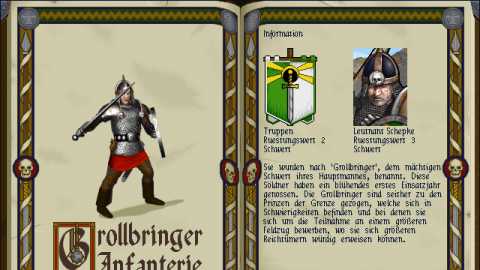Overview
Warhammer: Shadow of the Horned Rat is a real-time tactics strategy game published by Games Workshop (in conjunction with Mindscape) in 1995. It was one of the first games with full, 360 degrees rotation of the battlefield and had a fine (for it's day) mix of 2D unit sprites on a 3D landscape.
Plot
An experienced commander of a small mercenary force, conisting of a cavalry and infantry unit, Morgan Berhardt is at first doing his usual job - eliminating small time bandits and goblin warbands in the region of Border Princess and getting a tiny bit of gold for it. But soon he becomes a part of a bigger picture, as one of the powerful Skaven mages, grey seer Tuhanquol gives one of the Orc warbosses a powerful axe and uses him and his huge greenskin horde as a distraction to further his plans, namely - conquering the Empire. Berhnardt unwillingly becomes the main force foiling Tuhanquol's plans, at first accidentally, as his army grows bigger and stronger, and he employs the help of the Dwarves, the Elves of Loren Forest and the Emperor Karl Franz himself.
Game Mechanics
The game is divided into two parts - the tactical battles which form he core of the gameplay and the map view of the Old World, where the player can choose his next mission, hire additional mercenaries and replenish his losses.
The tactical part of the game sought to apply the rulesets of the tabletop wargame, Warhammer: Fantasy Battles in a real time strategy context. At the beginning of each mission you select a number of units from your reserves to send into battle. Units are hired with gold, their cost based on the unit's size, strength, and skill level. There's also a constant retainer cost just for keeping a unit in the army. If your gold reserve is depleted you will no longer afford to hire the essential core unit, and the game will end. Once units are selected, most missions allow you to deploy your army however you wish, though some feature an ambush and you can only determine the marching order of your army. Some missions feature no battle at all, and any money spent to employ units is wasted. When the start button is pressed a peal of thunder is heard and the battle commences. You can then select and give orders to units on the battlefield. There are a variety of roles each unit can perform in combat: shooting ranged weapons, charging into melee, casting spells, and using magic items. During combat, the player is able to spur a unit to fight harder, at the cost of his attention to the rest of the battle. Many of the concepts of morale, and flank attacks are features of the tabletop game. As a result, a player that has not encountered the tabletop iteration of Warhammer may have issues with these concepts at first. A mission can turn badly quite suddenly when a single bad "round" of combat can result in the player's elite cavalry fleeing from a unit of pitiful goblins.
Difficulty
The learning curve of this game can be steep. The beginning has small battles with few units, though even those can turn nasty quite quickly. Replacing casualties in a unit costs money, and is always limited. Some locations may not offer any replacements at all, while some may offer only 10 across the your entire army. Even worse is that if a unit is completely destroyed it is usually gone for good, which includes the rare, valuable, and fragile wizards. As the game progresses the difficulty of individual scenarios and the overall situation compounds. The player gains more units and battles get larger, but you can't pause the game to give orders. It will often be necessary to manage multiple wizards, target ranged units, launch charges, and set up flank attacks in very short spans of time. It's easy to end a battle successfully and only then notice that a key mortar was destroyed in combat, requiring a restart.
As a result of a difficulty so hard, that even the experienced RTS players had a tough time finishing the game, many of the game's more painful elements, like the retainer cost, the constant need for attention for every single unit and clunky interface were changed in it's more aproachable (yet still very hard) and more succesful sequel, Warhammer: Dark Omen.


 PlayStation
PlayStation PC
PC







